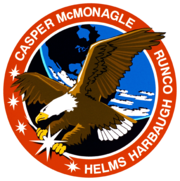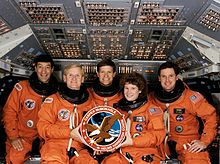STS-54
This article includes a list of references, related reading, or external links, but its sources remain unclear because it lacks inline citations. (May 2008) |
| COSPAR ID | 1993-003A |
|---|---|
| SATCAT no. | 22313 |
| End of mission | |

 | |
STS-54 Shuttle-TDRS mission was a Space Transportation System (NASA Space Shuttle) mission, launched January 13, 1993.
Crew
- John Casper (2), Commander
- Donald R. McMonagle (2), Pilot
- Mario Runco, Jr. (2), Mission Specialist 1
- Gregory J. Harbaugh (2), Mission Specialist 2
- Susan J. Helms (1), Mission Specialist 3
Mission parameters
- Mass:
- Orbiter landing with payload: 92,988 kg
- Payload: 18,559 kg
- Perigee: 302 km
- Apogee: 309 km
- Inclination: 28.5°
- Period: 90.6 min
Space walks
- Harbaugh and Runco - EVA 1
- EVA 1 Start: January 17, 1993
- EVA 1 End: January 17, 1993
- Duration: 4 hours, 28 minutes
Mission highlights


The primary payload was the fifth Tracking and Data Relay Satellite (TDRS-F) which was deployed on day one of the mission. It was later successfully transferred to its proper orbit by the Inertial Upper Stage booster.
Also carried into orbit in the payload bay was a Hitchhiker experiment called the Diffuse X-ray Spectrometer (DXS). This instrument collected data on X-ray radiation from diffuse sources in deep space.
Other middeck payloads to test the effects of microgravity included the Commercial General Bioprocessing Apparatus (CGPA) for-life sciences research; the Chromosome and Plant Cell Division in Space Experiment (CHROMEX) to-study plant growth; the Physiological and Anatomical Rodent Experiment (PARE) to examine the skeletal system and the adaptation of bone to space flight; the Space Acceleration Measurement Equipment (SANS) to measure and record the microgravity acceleration environment of middeck experiments; and the Solid Surface Combustion Experiment (SSCE) to measure the rate of flame spread and temperature of burning filter paper.
Also, on day five, mission specialists Mario Runco and Gregory J. Harbaugh spent nearly 5 hours in the open cargo bay performing a series of space-walking tasks designed to increase NASA's knowledge of working in space. They tested their abilities to move about freely in the cargo bay, climb into foot restraints without using their hands and simulated carrying large objects in the microgravity environment.
See also
- Space science
- Space shuttle
- List of space shuttle missions
- List of human spaceflights chronologically

